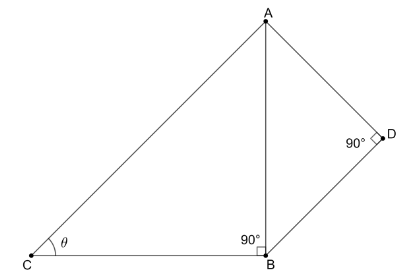
In the adjoining figure, $ \text{AD}=4\text{ cm} $ , $ \text{BD}=3\text{ cm} $ and $ \text{CB}=12\text{ cm} $ . Find $ \cot \theta $ .


Answer
552.3k+ views
Hint:
We have two right-angled triangles. In one triangle, we know the measurements of two sides. We will use the Pythagoras theorem to find the length of the third side. After that, we will have the lengths of two sides of the other right angled triangle. We will use the definition of the trigonometric function $ \cot \theta $ to obtain the desired value.
Complete step by step answer:
Let us consider $ \Delta \text{ABD} $ . We have $ \text{AD}=4\text{ cm} $ , $ \text{BD}=3\text{ cm} $ and $ \angle \text{ADB}=90{}^\circ $ . We will use the Pythagoras theorem to find the length of the hypotenuse AB. The Pythagoras theorem states that
$ {{\left( \text{hypotenuse} \right)}^{2}}={{\left( \text{side 1} \right)}^{2}}+{{\left( \text{side 2} \right)}^{2}} $
Substituting the sides of $ \Delta \text{ABD} $ , we get
$ {{\left( \text{AB} \right)}^{2}}={{\left( \text{AD} \right)}^{2}}+{{\left( \text{BD} \right)}^{2}} $
Therefore, substituting the lengths, we have the following
$ \begin{align}
& {{\left( \text{AB} \right)}^{2}}={{\left( 4 \right)}^{2}}+{{\left( \text{3} \right)}^{2}} \\
& \Rightarrow {{\left( \text{AB} \right)}^{2}}=16+9 \\
& \Rightarrow {{\left( \text{AB} \right)}^{2}}=25 \\
& \therefore \text{AB}=5\text{ cm} \\
\end{align} $
Now, let us consider $ \Delta \text{ABC} $ . We have $ \text{AB}=5\text{ cm} $ , $ \text{CB}=12\text{ cm} $ , $ \angle \text{ABC}=90{}^\circ $ and $ \angle \text{ACB}=\theta $ . In a right angled triangle the definition of the trigonometric function $ \cot \theta $ is the following,
$ \cot \theta =\dfrac{\text{Adjacent}}{\text{Opposite}} $
The adjacent side to the angle $ \theta $ in $ \Delta \text{ABC} $ is CB and the opposite side is AB. Hence, we have
$ \cot \theta =\dfrac{\text{CB}}{\text{AB}} $
Substituting the values of the lengths of the sides, we get
$ \cot \theta =\dfrac{12}{5} $ .
Note:
We should be aware of the properties of a right-angled triangle for this type of question. The figure and the given information are the biggest hints for us to choose the correct property or formulae that can be used in order to get the required answer. The knowledge of trigonometric functions and their definitions is necessary to obtain the desired answer. We can derive the definition of all trigonometric functions even if we know only the definitions of the sine and cosine functions. But for this, we should understand the relations among the trigonometric functions.
We have two right-angled triangles. In one triangle, we know the measurements of two sides. We will use the Pythagoras theorem to find the length of the third side. After that, we will have the lengths of two sides of the other right angled triangle. We will use the definition of the trigonometric function $ \cot \theta $ to obtain the desired value.
Complete step by step answer:
Let us consider $ \Delta \text{ABD} $ . We have $ \text{AD}=4\text{ cm} $ , $ \text{BD}=3\text{ cm} $ and $ \angle \text{ADB}=90{}^\circ $ . We will use the Pythagoras theorem to find the length of the hypotenuse AB. The Pythagoras theorem states that
$ {{\left( \text{hypotenuse} \right)}^{2}}={{\left( \text{side 1} \right)}^{2}}+{{\left( \text{side 2} \right)}^{2}} $
Substituting the sides of $ \Delta \text{ABD} $ , we get
$ {{\left( \text{AB} \right)}^{2}}={{\left( \text{AD} \right)}^{2}}+{{\left( \text{BD} \right)}^{2}} $
Therefore, substituting the lengths, we have the following
$ \begin{align}
& {{\left( \text{AB} \right)}^{2}}={{\left( 4 \right)}^{2}}+{{\left( \text{3} \right)}^{2}} \\
& \Rightarrow {{\left( \text{AB} \right)}^{2}}=16+9 \\
& \Rightarrow {{\left( \text{AB} \right)}^{2}}=25 \\
& \therefore \text{AB}=5\text{ cm} \\
\end{align} $
Now, let us consider $ \Delta \text{ABC} $ . We have $ \text{AB}=5\text{ cm} $ , $ \text{CB}=12\text{ cm} $ , $ \angle \text{ABC}=90{}^\circ $ and $ \angle \text{ACB}=\theta $ . In a right angled triangle the definition of the trigonometric function $ \cot \theta $ is the following,
$ \cot \theta =\dfrac{\text{Adjacent}}{\text{Opposite}} $
The adjacent side to the angle $ \theta $ in $ \Delta \text{ABC} $ is CB and the opposite side is AB. Hence, we have
$ \cot \theta =\dfrac{\text{CB}}{\text{AB}} $
Substituting the values of the lengths of the sides, we get
$ \cot \theta =\dfrac{12}{5} $ .
Note:
We should be aware of the properties of a right-angled triangle for this type of question. The figure and the given information are the biggest hints for us to choose the correct property or formulae that can be used in order to get the required answer. The knowledge of trigonometric functions and their definitions is necessary to obtain the desired answer. We can derive the definition of all trigonometric functions even if we know only the definitions of the sine and cosine functions. But for this, we should understand the relations among the trigonometric functions.
Recently Updated Pages
Master Class 10 Computer Science: Engaging Questions & Answers for Success

Master Class 10 General Knowledge: Engaging Questions & Answers for Success

Master Class 10 English: Engaging Questions & Answers for Success

Master Class 10 Social Science: Engaging Questions & Answers for Success

Master Class 10 Maths: Engaging Questions & Answers for Success

Master Class 10 Science: Engaging Questions & Answers for Success

Trending doubts
Why is there a time difference of about 5 hours between class 10 social science CBSE

Write a letter to the principal requesting him to grant class 10 english CBSE

What is the median of the first 10 natural numbers class 10 maths CBSE

The Equation xxx + 2 is Satisfied when x is Equal to Class 10 Maths

Which of the following does not have a fundamental class 10 physics CBSE

State and prove converse of BPT Basic Proportionality class 10 maths CBSE




